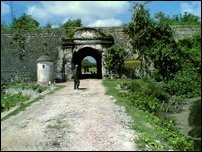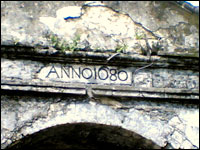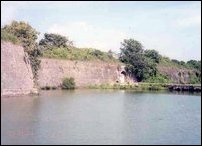Jaffna fort to be readied for new colonial masters
[TamilNet, Saturday, 10 October 2009, 10:35 GMT]In the name of archaeology the Dutch fort of Jaffna is going to be renovated by the Department of Archaeology of Sri Lanka as an abode for visiting Colombo’s dignitaries and Sinhala Buddhist ‘pilgrims,’ news reports say. The fort of Jaffna, originally built by the Portuguese and made into its present form by the Dutch in the 17th century, never ceased to be a symbol of oppression to the people of Jaffna. It never became the cultural property of Tamils to whom it rightfully belongs. After the so-called independence it served as provincial prison, quarters for the Sinhala security forces and the King’s House inside was the guesthouse for Colombo’s politicians. The Sinhala politicians who burnt the Jaffna library in 1981 executed it from the King’s House and the police that killed audience and disturbed the 4th International Tamil Conference in 1974 came from the fort.
This is for the kind note of the Netherlands ambassador who on Wednesday visited Jaffna and the fort, to remind him of the duty of Netherlands to see the heritage is returned to the people of Jaffna, which the Dutch considered as ‘Little Holland’ in those days, commented an academic in Jaffna.
Colombo is sure to approach Netherlands for funds to pay its ‘archaeologists’ and tourism infrastructure.
Neither the Archaeology Department, nor the National Archives of Sri Lanka has Tamil officers. Perhaps because, as often addressed to in derogation, even by high profile people like Basil Rajapaksa, the ‘Para Demalas’ (Para in Sinhala means outsider as well as outcaste), have neither history nor heritage in the island, said a Tamil researcher in Colombo who experienced the difficulty in even getting access to material in the archives.
Archaeology department officials of Sri Lanka, and all of them Sinhalese, visited Jaffna recently showing interest in the ‘monuments’ in the peninsula, ostensibly to invite ‘tourist attraction’ for the ‘development’ of Jaffna, but actually on an agenda of cultural genocide, the academic in Jaffna said.
The most important archaeological site, Kantharoadai in the peninsula, is of Megalithic origins dating back to c. 1000 BCE, as revealed in an excavations conducted by the Pennsylvania University in the 1960s. It was one of the earliest urban centres of the island, parallel to Anuradhapura, interacting far and wide with the outside world. The megalithic culture is widely acknowledged as an expression of Dravidian civilisation in South India and in the island of Sri Lanka.
The subsequent Buddhist phase of the site is a unique manifestation in concept and architecture, significantly different from the ones found in the south of the island and is often recognised as a heritage of Tamil Buddhism. This heritage of Jaffna is identified as one that is closely associated with the genre of Buddhism found mentioned in the Tamil Buddhist epic Ma’nimeakalai of the early centuries of the Common Era.
Kantharoadai (Kanthar+oadai) simply means the pond of Kanthar. It may even be a relatively later name. Rudimentary excavations made at this site by Paul E Pieris, a Sinhala judge serving in Jaffna in early 20th century, made Mudaliyar Rasanayagam who wrote a history of Jaffna by that time to presume that a place Kathirai-malai mentioned in the historiographical literature of Jaffna as the capital of a kingdom that exited in the peninsula in ancient times was at Kantharoadai.
Kathirai-malai was translated into Sinhala as Kaduru-goda and a feature that appeared in Sunday Times a month ago on salvaging archaeology in the peninsula now says “The Kadurugoda Buddhist temple in Jaffna which is also known as Kantarodai is of significant religious importance due to around 40 small and medium-sized dagobas found among its artefacts.”
The Colombo government today doesn’t want even to recognise the Eezham Tamil Kingdom of Jaffna that existed since 13th century until its conquest by the Portuguese in 1618 CE. Recently there was a move by the government to remove the history of it from textbooks.
The Sinhala archaeology enthusiasts, in order to show their ‘balance’ and hoodwink Tamils, now want to renovate a structure which they have invented as ‘Manthiri Walauwa’ (minister’s house or premises) in Nalloor, claimed as belonging to the times of the kings of Jaffna.
The reference ‘Manthiri Manai’ (Manai means house) to this structure is a conflated identity but is now taken over by Colombo’s ‘archaeologists’. It was actually a chaultry built in early 19th century along with the belfry of the adjacent Chaddai-naathar temple, by a philanthropist of Va’n’naarpa’n’nai of Jaffna (see Silver Jubilee Number of Jaffna Hindu Ladies College).
Meanwhile, a tank considered as belonging to the times of the kings of Jaffna and identified with a name Yamuna-Eari, found in the historiographical literature of Jaffna, is now called Yamuna-Poku’na by Colombo’s archaeology mandarins.
This is how the Sri Lankan State ‘educate’ Tamils of their archaeological heritage and going to ‘sell’ it to others too, commented the academic in Jaffna who doesn’t enjoy the academic freedom of even revealing his name.
On Monday, TNA parliamentarian Suresh Premachandran in a press conference in Jaffna said that a big Buddhist temple is being built in Ki’linochchi, on claims that it is an ancient one and many small Buddhist stupas are built along the A9 highway in the north, to settle Sinhala Buddhists in the north.
Will Sri Lankan state encourage Tamils to make pilgrimage and establish a colony in Dondra Head, the southern tip of the island where there was an ancient Siva temple called Theanavarai Naayanaar, mentioned in the Tamil inscription of Galle, asks a religious activist in Colombo.
A few months back Colombo banned annual religious festival of a Hindu temple in the upcountry, saying that it will incite Sinhala-Buddhists. But, last month when hundreds of thousands are incarcerated, the government conducted a ‘Thamaasha’ of Hindu Conference in Colombo inviting participants from India.



கருத்துகள் இல்லை:
கருத்துரையிடுக